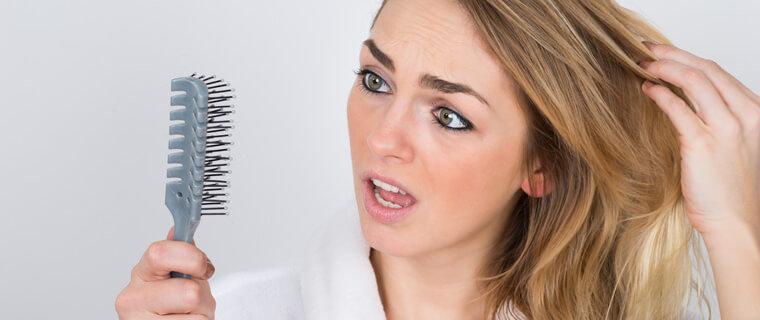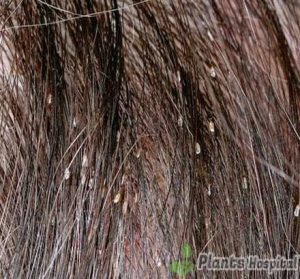Table of Contents
Hair Loss in Women
Although hair loss may seem like a more prominent problem in men, women are nearly as likely to lose or have thinning hair. Most women notice it in their 50s or 60s, but it can happen at any age and for a variety of reasons.
Hair Loss Causes in Women
Excessive hair loss is probably among the top concerns for both men and women. After all, your hair is one of the first things people notice about you. Hair becomes naturally thinner with age, but there are many other underlying causes.
Hair loss can take many forms, including the gradual thinning, patchy bald spots, sudden loosening of hair, and more.
It is important to discuss your family history, habits, health issues and medications, and how you are losing hair with your doctor to establish a cause and to find appropriate treatment. Let’s examine some of the reasons why hair loss occurs.
Common Causes of Hair Loss in Women
Sudden Hair Loss
- Alopecia areata
- Telogen effluvium
- Tinea capitis
- Some scarring
- Alopecias
Gradual Hair Loss
- Female and male pattern hair loss
- Traction alopecia
- Trichotillosis
- Some scarring alopecias
Focal Hair Loss
- Alopecia areata
- Female and male pattern hair loss
- Tinea capitis
- Traction alopecia
- Trichotillosis
- Scarring alopecias

Diffuse Hair Loss
- Alopecia total is (the type of alopecia areata)
- Drug-induced hair loss
- Iron deficiency anemia, hypothyroidism
- Telogen effluvium
Male or Female Pattern Baldness
Although men and women lose hair in different ways, and at different times, heredity plays a role in both genders, especially when it comes to the pattern and extent of the hair loss.
Men begin to lose hair earlier in life, and usually, the hairline recedes partially or completely. For women, the hair becomes thinner in the front, sides, or top of the head.
Alopecia
Scarring Alopecia, characterized by inflamed hair follicles, and alopecia areata, an autoimmune disorder, both lead to hair loss.
Scarring alopecia has been linked to conditions such as lupus, and alopecia areata appears in otherwise healthy people, although it may be linked to thyroid disease and other autoimmune disorders.
Another reason for hair loss can be traction alopecia, in which hair is repeated pulled back so tightly that the roots weaken and the hair falls out.
What is Androgenetic Alopecia?
Androgenetic alopecia is the most common type of progressive hair loss. It is also known as male-pattern baldness, female-pattern baldness, or just common baldness.
It affects about 50% of men over the age of 50 and about 50% of women over the age of 65. In women the severity varies, it may present as widespread hair thinning but in some cases, it can lead to complete
baldness.

What Causes Androgenetic Alopecia?
Androgenetic alopecia is caused by a combination of genetic and hormonal factors. Dihydrotestosterone (DHT) is the main hormone responsible for androgenetic alopecia in genetically susceptible individuals.
DHT causes scalp hair loss by inducing a change in the hair follicles on the scalp. The hairs produced by the affected follicles become progressively smaller in diameter, shorter in length and lighter in color until eventually the follicles shrink completely and stop producing hair.
Is Androgenetic Alopecia Hereditary?
Yes. It is believed that genetic susceptibility to this condition can be inherited from either or both parents.
What Are The Symptoms of Androgenetic Alopecia?
Androgenetic alopecia affects men earlier, and more commonly than women. Males typically become aware of scalp hair loss or a receding hairline, beginning at any time after puberty. In women, the age of onset is later compared to men, usually occurring in the 50s or 60s. Occasionally, androgenetic alopecia in women may start earlier than this, in the 30s or 40s. In some women, this condition can be associated
with an excess of male hormones such as in polycystic ovary syndrome (PCOS). Acne, increased facial hair, irregular periods and infertility are all signs of PCOS.
Telogen Effluvium
When hair falls out suddenly – after a traumatic event, such as a loss of a loved one, or a major health issue – it is usually because of telogen effluvium.
It can happen a few times to the same person, as some people are more susceptible to telogen
effluvium than others. The good news is, hair generally grows back, especially if treated.
- Telogen effluvium results in faster cycling of the hair, and loss of telogen hairs at the roots
- Often triggered by illnesses or hospitalizations, pregnancy, medications, or significant mental stressors
- Usually resolves within 6-12 months of onset
- Lasts longer for some people, especially with subtle changes in estrogens, thyroxine, androgens, retinoids, cortisol, ferritin, vitamin D3, beta-blockers, and general anesthetics
- These are involved in hair cycle regulation
Nutrition
While genetics in the case of hair loss may be stronger than environmental factors, the latter shouldn’t be overlooked.
People with an iron or a vitamin B12 deficiency may experience hair loss. Protein deficiency can also cause these symptoms. Likewise, an overuse of anabolic steroid – even in a person with a healthy diet – can be an underlying cause for baldness.
A kerion is a painful inflammatory, boggy mass with broken hair follicles. May discharge pus, frequently confused with a bacterial infection, but can also be superinfected.
Kerion carries a higher risk of scarring (permanent hair loss) than other forms of tinea capitis. Expeditious referral to or contact with a dermatologist recommended. May consider oral prednisolone with an antifungal if kerion is present.
Prevent Spread
- Don’t share towels, brushes, combs, hats, or hair accessories.
- Clean hair clippers with antifungal sprays.
- Screen family members for symptoms and culture them; treat if present
- Ketoconazole or selenium sulfide shampoo (left on 5-10 minutes before rinsing) several times a week may help reduce spread.
Trichotillosis (trichotillomania)
- Caused by pulling on the hair.
- Different lengths of hair in the patch; may also have black dots from short hairs.
- Lacks scale or inflammation.
- Screen for anxiety, depression.
Traction Alopecia:
- The gradual loss of hair at the frontal hairline and sides due to the history of pulling hairstyles.
- Characterized by “fringe” along the hairline.
- More common in African-American women.
Evaluation of Diffuse Hair Shedding
- Labs: TSH, T4, CBC, ferritin, iron studies, Vitamin D3.
- Each of these can contribute to changes in hair cycling.
- Iron deficiency is the most common treatable cause of hair shedding in women.
- Consider RPR if at risk for syphilis.
Medications May Cause Hair Loss in Women
For some, hair loss is a side effect of the medication they are taking. It is known, for example, that some of the arthritis medications and blood thinners have this side effect. Also, chemotherapy and radiation therapy can cause hair loss, but the hair usually grows back after the treatment is over.
- Estrogens, beta-blockers, oral retinoids, levothyroxine, tricyclic antidepressants, metformin.
- Many medications are reported to cause hair loss in clinical trials because it’s a common complaint
Health Issues
Conditions such as diabetes, lupus, and high blood pressure are known to contribute to
baldness. Also, psychological issues such as depression and eating disorders can
lead to hair loss. Trichotillomania, a disorder in which people compulsively pull their hair out, is another potential cause.
Hormonal Imbalances
Women undergo massive hormonal changes at different points of their lives – during pregnancy, after childbirth, at the onset of menopause, after discontinuing birth control, etc.
During pregnancy, for example, many develop thicker hair, which they then shed after delivery. Polycystic ovary syndrome is another potential cause of female hair loss.
Whatever the cause, there are solutions for every type of underlying issue, whether for temporary or permanent hair loss.
Female Pattern Hair Loss
- FPHL occurs in half of the women by their 80s.
- Unlike male-pattern loss, women tend to maintain their hairline.
- Tend to thin on top and spread down slowly.
- Men go “bald”; Women go “thin”.
- May start much earlier in some women.
Medical Treatments & Home Remedies
Minoxidil
- OTC 5% minoxidil foam daily is less irritating than using the solution twice daily.
- May have some shedding when first using.
- It takes 6-12 months to see if it will slow the loss.
- Discontinuing will result in some hair loss
Hair Transplantation
Hair transplant is one of the most expensive hairs loss treatments. It requires a surgical process that is very painful, invasive, and leads to scars. But, the surgically planted hair not only grows but also remains with you for a long time.
Jojoba oil is a powerful home remedy that has been in use for more than a hundred years. It has a powerful effect on hair growth when rubbed into the scalp and the hair, particularly at the spot where you’ve noticed the loss.
Coconut Oil Massage
You can heat some coconut oil and use it to massage the scalp with your finger-tips. This is beneficial in increasing the blood flow to hair follicles, thereby strengthening and conditioning them.
This can be a very effective way to prevent the formation of dihydrotestosterone, similar to saw palmetto. Dihydrotestosterone comes from testosterone but licorice does not allow the hormone to go through this transition.
Second-Line Therapies
- May benefit from low-level laser light therapy.
- Finasteride (only if postmenopausal), [cyproterone, flutamide], and spironolactone.









Its pleasure for your opinion. I want to know how oily scalp causes can attack and damage our hairs?
Hello there,
one big article with tons of information, really I appreciate your effort . Here I get to know lot of things that really help me to know how and why women loss hair and I guess I could able to help my lovely wife to fight back with her hair fall. Thanks for the sharing and hope we get more from here real soon.